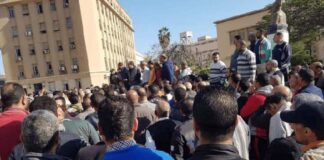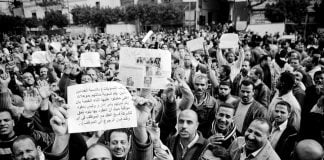Mass people power brought down Mubarak’s dictatorship one year ago. Amy Thomas and Ernest Price look at where Egypt’s continuing strikes and demonstrations are heading
“Massive and effective street protest was a global oxymoron until—suddenly, shockingly… it became the defining trope of our times. And the protester once again became a maker of history.”
This was Time magazine in December last year explaining its decision to award their Person of the Year to “The Protester”. That a magazine like Time (not exactly known as a bastion of radicalism) would celebrate street protest is a sign of just how much ordinary people changed the world in 2011.
Egypt’s revolution became a symbol for global resistance—from the “Indignados” in Spain, who, moved by the scenes of Tahrir Square, replicated them at home, to the Occupy movement in the United States that drew attention to the vast class inequality, to the Greek workers who have led the way against austerity in Europe with a series of general strikes.
Egypt’s revolution was itself encouraged by the toppling of Ben Ali in Tunisia and has since inspired the masses of Libya, Yemen, Bahrain and Syria to rise up.
Linking all the struggles is the devastation caused by the economic crisis. In the United States last year, two million Americans lost their homes to the banks. In Spain, youth unemployment is nearing 50 per cent and both major parties support austerity measures that are making this worse.
In Egypt, just prior to Mubarak’s downfall, the crisis had pushed up food prices as much as 25 per cent. Remittances sent home from families working in Europe were decreasing as immigrants felt the brunt of job cuts.
Mubarak was not just a brutal dictator, but a multi-billionaire one (worth $70 billion according to some reports) in a country where 40 per cent of people live below the poverty line. The slogans on the street in January 2011—“bread, freedom, dignity”—were not just for toppling the regime but for tackling poverty and oppression. Wassim Wagdy, an Egyptian socialist, explained this dynamic in January 2011: “They [Egyptians] have amalgamated the economic and political, the call for a better life and desire for freedom, and concentrated it all in the will to change the regime.”
And that is precisely why, more than one year later, the revolution remains “unfinished”. Egyptians have torn the head off the beast but the body lives on in the form of the Supreme Council of Armed Forces (SCAF)—which assumed power when Mubarak fell.
The army
During the struggle against Mubarak the army positioned itself on the protesters’ side. A popular slogan was “the people and the army are one hand”. Socialists were alone in consistently putting the case that SCAF was there to wind the struggle down, as an agent of counter-revolution rather than revolution.
But the experience of SCAF’s rule has given that argument a new audience. Now, a common slogan is “the people and the army are one very dirty hand.”
The army has been the ruling institution in Egypt since 1952. The top levels of the army are built into the networks of wealth and privilege of the top 1 per cent, or the ruling class. Up to 15 per cent of the Egyptian economy is run by the army—and they don’t pay any taxes on the profits.
Mubarak met his end thanks not just to the mass protests in Tahrir but to a mass strike wave that threatened the flow of profits. The military generals thought they could sacrifice Mubarak to appease the movement while leaving the rest of the dictatorship in place.
But they didn’t count on the transformation of Egyptians in the course of the revolution. Emboldened by their victory, Egyptians were not going to settle for cosmetic change without a fight. And the struggle had already brought profound change to its participants who had been given a glimpse of their collective power. Women, long fearful of sexual harassment on the street, had joined the revolution as men’s equals and slept alongside their fellow revolutionaries in Tahrir Square without harrassment, debating politics and playing a leading role.
The workers’ movement
The strike wave that brought down Mubarak gave workers a sense of their power to act collectively as a class.
Their new-found confidence fed back into the union movement. Before the revolution there were just three independent trade unions, now there are over 100. In September, 500,000 workers took industrial action in the biggest strike wave since the 1940s.
Economic demands for a minimum wage have been raised alongside political demands to sack the “little Mubaraks” in the form of Mubarak-era bosses and corrupt union officials (a process referred to as “tathir” or “cleansing”).
Doctors, for example, led a national strike in May to demand better funding for health care alongside demands about their own wages and conditions, and took their union back from corrupt officials.
In her book The Mass Strike, Rosa Luxemburg theorises from the experience of the Russian revolution of 1905, how mass strike action can be a bridge from day-to-day struggles to the battle for a new society. Strikes may begin over what appear to be small economic demands but can rapidly generalise to broader political demands.
The links between the political and economic demands are encouraged in Egypt by the refusal of management and SCAF itself to give any concessions in the face of the economic crisis. In February 2011, SCAF officially banned strikes.
Now, SCAF is proposing Europe-style austerity in the form of $20 billion in cuts to public spending.
So in demanding economic change, Egypt’s workers are facing up to SCAF’s stubborn commitment to the logic of capitalist profit and competition, and beginning to push against it.
The working class, the biggest in the Middle East, has immense power. Using strikes as their weapon, Egypt’s workers could stop the flow of oil through the Suez Canal and shut down every single one of the army’s businesses.
But there are big challenges before the workers’ movement can get to such a point. A call for a general strike on February 11 was only successful across the education sector. A massive media campaign by SCAF associated the main agitators for the strike, the Revolutionary Socialists, with foreign agents. Textile workers’ leader Kamal al-Fayoumy was taken into custody for several days.
SCAF’s generals understand the power of the working class on the move and will do what they can to slow it down.
The elections and the Brotherhood
SCAF hoped that the elections held in late 2011 would deflect mounting opposition. In reality, the landslide victory for the Muslim Brotherhood—the only major (and semi-legal) opposition party under Mubarak—reflected the desire for change.
The Muslim Brotherhood gained around two thirds of the parliamentary seats. The experience of voting in a clean parliamentary election was something most Egyptians had never experienced. The high hopes were reflected in the fact that a call from some of the left to boycott the elections went nearly entirely unheeded.
But the direction being taken by the Muslim Brotherhood’s leadership is already starting to raise questions about its role.
Contrary to Western media hype, the danger presented by the Brotherhood is not radical Islamism but the commitment of the top layer of the Brotherhood to pro-market policies. They are firmly involved in ruling the country and running the economy and are willing to appease SCAF in order to keep their seat at the table.
As much as they might scaremonger about Islamism, US diplomats have met repeatedly with the Muslim Brotherhood and want them to use their legitimacy and popularity to hold the revolution back. The danger is very real. The Brotherhood joined SCAF in condemning the February 11 strike.
But the Brotherhood is also being pulled in the other direction by their young members involved in the revolution, who support the call for nationalisation of industry and a minimum wage.
Last November, mass demonstrations calling for the immediate transfer of power, particularly in the cities, broke out against the violent repression of a protest in Tahrir Square.
Scores of Egyptians were killed in the crackdown, but the repression encouraged a layer of young revolutionaries to call for SCAF’s overthrow. The demonstration in Tahrir Square on January 25 on the revolution’s anniversary turned into a demonstration against the new regime. Estimates put the crowd at over one million in Cairo alone.
The Brotherhood had come simply to celebrate the revolution, but large sections of the crowd attempted to drown them out with chants like, “This is a revolution, not a party”, and “freedom, justice, social equality.”
All of these demonstrations were attended by Brotherhood supporters from the mosques.
A challenge for the revolutionaries in the coming period will be to win over those with faith in the Brotherhood and parliament.
The future
The aspirations of Egypt’s masses will not be met by SCAF, parliament—or within the limits of capitalism itself. But the struggle within capitalism in Egypt for democracy and economic reform has the potential to turn into a socialist revolution against the system.
In the Russian revolution of 1905, mass strikes and demonstrations led to the creation of workers’ councils that began to organise every aspect of life, offering a new form of power against the Tsarist dictatorship.
The direct, popular democracy that was a feature of Tahrir Square can be extended to the workplaces and all of Egypt. Workplace councils can come together across Egypt to co-ordinate the struggle and to take control of society away from SCAF. The army itself could be literally disarmed if workers were strong and united enough to win soldiers over to their side.
Such a society could redistribute the wealth of the country (now controlled nearly-exclusively by the military and a group of 100 super rich families) and use it to meet human needs.
For this to happen, the independent organisation of workers will need to deepen, and the strength of the forces arguing for revolutionary politics in the workplaces and the squares will need to grow and spread.
The bravery and courage of the Egyptian people has opened up the possibility of a socialist alternative to capitalism, a vision that holds the key to the struggles in the Arab world, across Europe, and everywhere else. It’s their bravery and courage that can make it a reality.






